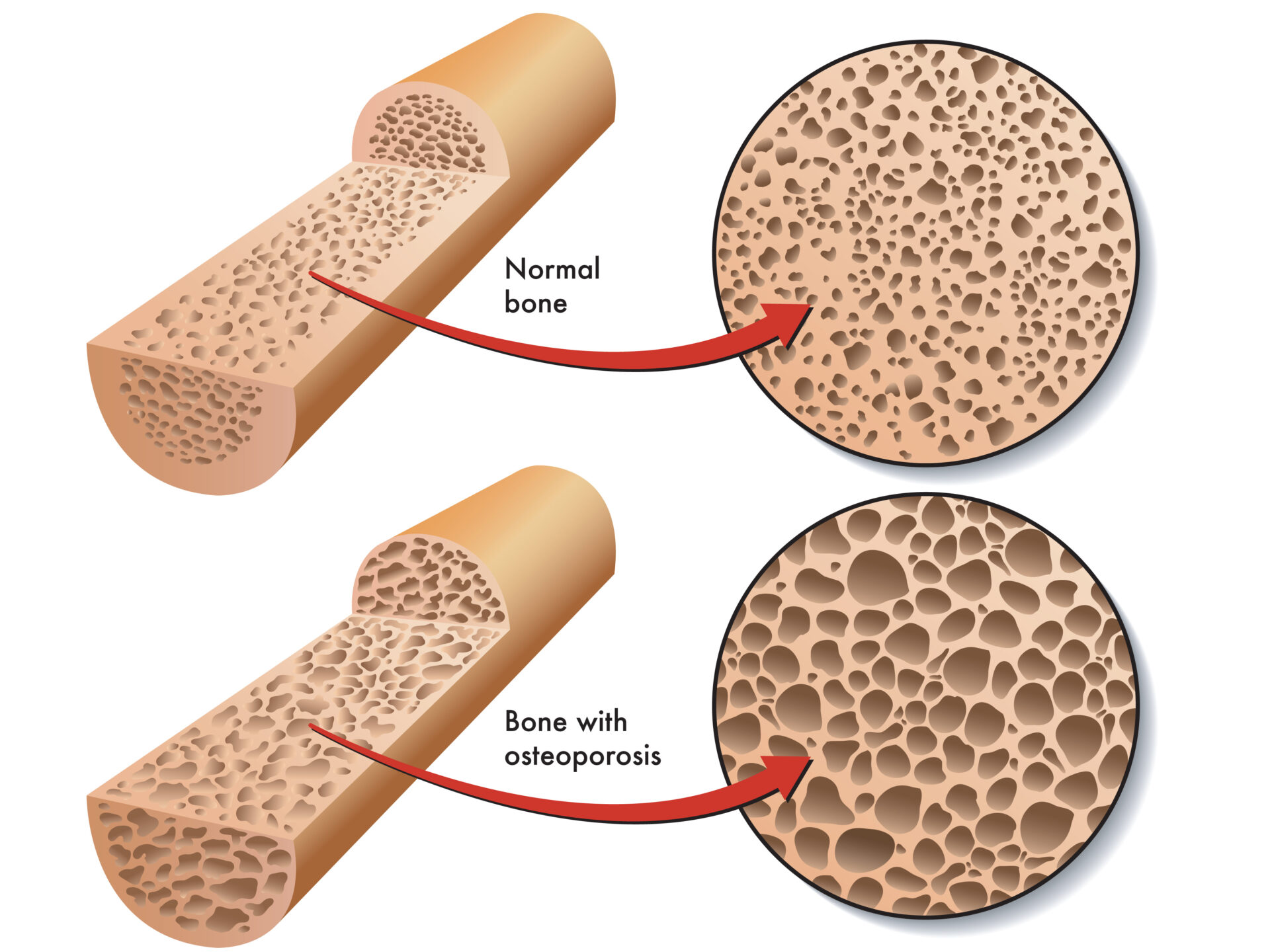Osteoporosis is a condition characterized by a decrease in the density of bone, decreasing its strength and resulting in fragile bones. Osteoporosis literally leads to abnormally porous bone that is compressible, like a sponge. This disorder of the skeleton weakens the bone and results in frequent fractures (breaks) in the bones.
Normal Healthy bone is composed of protein, collagen, and calcium all of which give bone its strength. Bones that are affected by osteoporosis can break with a relatively minor injury that normally would not cause a bone to fracture. The fracture can be either in the form of cracking (as in a hip fracture) or collapsing (as in a compression fracture of the vertebrae of the spine). The spine, hips, ribs, and wrists are common areas of bone fractures from osteoporosis although osteoporosis-related fractures can occur in almost any bone.
When you exercise, you don’t just build muscle and endurance. You also build and maintain the amount of and thickness of your bones. This is known as bone mass and density.
What are the symptoms of osteoporosis?
Osteoporosis can be present without any symptoms for decades because osteoporosis doesn’t cause symptoms until bone fractures. Moreover, some osteoporotic fractures may escape detection for years when they do not cause symptoms. Therefore, patients may not be aware of their osteoporosis until they suffer a painful fracture. The symptom associated with osteoporotic fractures usually is pain; the location of the pain depends on the location of the fracture. For example, some patients with osteoporosis develop stress fractures of the feet while walking or stepping off a curb.
Hip fractures typically occur as a result of a fall. With osteoporosis, hip fractures can occur as a result of trivial accidents. Hip fractures also may heal slowly or poorly after surgical repair because of poor healing of the bone.
Bone is scaffolding which supports the body against the force of gravity. Bones resist the pull of our muscles to allow movement. As bone is a living tissue, it reacts to appropriate weight-bearing exercise by growing stronger. This is how you support the weight of your own body.
The safe and sensible way to begin an exercise programme is to take your time and listen to your body. The type of exercise you do depends on your risk of fracture, your age, your medical history and your DXA scan results.
Benefits of exercise
It’s never too late to start exercising. As we age the rate of bone loss increases. Exercising regularly can increase bone density, improve muscle strength, improve co-ordination and balance which will help to avoid falls. Exercise also has added benefits beyond osteoporosis treatment and prevention such as reduced risk of heart disease, weight management and the prevention of high blood pressure. Calcium, the major component of bones, is not well absorbed unless a demand for it is created through exercise.
- Weight bearing exercises increase bone density
- Improve your balance
- Enable you to carry out daily tasks and activities
- Maintain or improve your posture
- Relieve or decrease pain
- Improve your sense of well-being
- Vary your programme to keep it interesting
How can exercise prevent osteoporosis?
Exercise works for osteoporosis prevention because muscle pulling on bone builds bone, so weight-bearing exercise increases bone density and build stronger bones. The more bone mass you build before age 25 or 30, the better off you will be during the years of gradual bone loss. Exercise can also help you to maintain bone density later in life.
Type of Exercise
- Weight-bearing
- Resistance
- Flexibility
All three types of exercise for osteoporosis are needed to build healthy bones.
Weight-bearing Exercise for Osteoporosis
Weight-bearing means your feet and legs support your body’s weight.
Examples of Weight-bearing Exercises:
- Gym based exercise programmes which can be tailored to suit specific requirements.
- Walking
- Dancing
- Climbing stairs or hills
Activities like cycling and swimming are great for your heart and lungs. However, these are not weight-bearing exercise and are not as beneficial for osteoporosis. That’s because you are being held up by something other than your feet and legs, such as the bicycle or the water.
Resistance Exercise for Osteoporosis
Resistance means you’re working against the weight of another object. Resistance helps with osteoporosis because it strengthens muscle and builds bone.
Examples of Resistance Exercises:
- Free weights or weight machines at the gym
- Resistance tubing that comes in a variety of strengths
- Yoga
- Pilates
For best results, do resistance exercises two or three times a week. Make the exercise more challenging by gradually adding weight or repetitions. Work all your different muscles including arms, chest, shoulders, legs, stomach, and back. Do not work the same muscle group two days in a row. Give each muscle group time to recover.
Flexibility Exercise for Osteoporosis
Flexibility is another important form of exercise for osteoporosis. Having flexible joints helps to prevent injury.
Examples of Flexibility Exercise:
- Yoga
- Pilates
- Shoulder & Arm Stretches
- Lower body Stretches
Making Exercise Safe for Osteoporosis
Many people worry about the safety of exercise later in life. You may be concerned if you already have osteoporosis or osteopenia. Perhaps you have never been very physically active. Whatever your concern, you can choose from a range of safe exercise options.
To ensure your safety during exercise for osteoporosis, keep these guidelines in mind:
Talk to your doctor before beginning any exercise program. This is especially important if you know you have bone loss or osteoporosis.
Weight-bearing exercise does not have to be high impact. Running, jogging and jumping may put stress on your spine. These high-impact activities may lead to fractures in already weakened bones. If you already have bone loss, choose gentler weight-bearing exercise like walking, dancing, low-impact aerobics.
If you already have osteoporosis, be careful of exercises that involve bending and twisting at the waist. This motion can put you at risk of fracture. Exercises that involve waist twisting include sit-ups, toe touches, and rowing machines. Golf, tennis, bowling, and some yoga poses also include some twisting at the waist. Talk to your doctor before choosing any of these activities.
Finally but most important, Exercise must be taken regularly to have any benefit. Little and often is the best strategy. Regular exercise must be a permanent lifestyle decision because if you stop, its beneficial effects gradually wear off. Muscles adapt to extra use within weeks but bones take several months.



